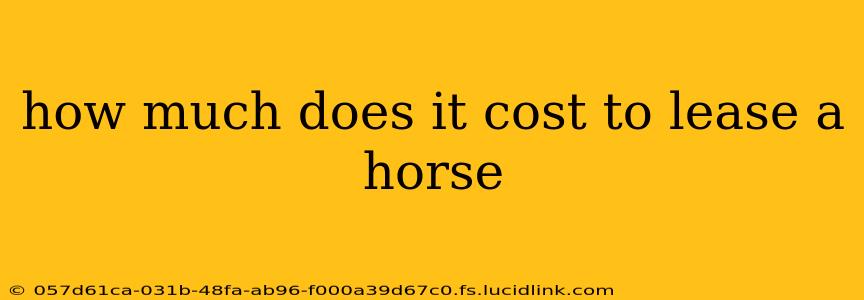Leasing a horse can be a fantastic way to experience the joys of horse ownership without the significant financial commitment. However, the cost of leasing varies considerably depending on several factors. This guide will delve into the specifics, helping you understand what to expect and how to budget effectively.
What Factors Influence Horse Lease Costs?
Several key elements determine the monthly or yearly cost of leasing a horse:
-
Horse's Discipline and Skill Level: A seasoned show jumper will command a higher lease fee than a beginner-friendly trail horse. The horse's training, experience, and competitive history significantly impact its value and, consequently, the lease price.
-
Location: Geographic location plays a crucial role. Leasing in a high-cost area like Southern California will be more expensive than leasing in a rural region. The cost of living and the overall equestrian market in the area influence leasing rates.
-
Boarding and Care Included: Lease agreements vary. Some include full board (stall, feed, hay, etc.), while others only cover partial board or pasture board, requiring the lessee to cover additional expenses. Always clarify what's included in the lease.
-
Lease Type: Full lease agreements typically cover all aspects of the horse's care, while half or partial leases involve shared responsibilities and costs with the owner. The level of responsibility directly impacts the lease price.
-
Horse's Age and Health: A younger, healthier horse may have a slightly higher lease cost than an older horse requiring more care or veterinary attention. The horse’s overall health and soundness are important considerations.
How Much Can I Expect to Pay?
Providing a precise number is impossible, as costs vary widely. However, a reasonable range is helpful:
-
Partial Lease: Expect to pay anywhere from $100 to $500 per month, depending on the factors mentioned above. This often involves sharing expenses with the owner.
-
Half Lease: This typically falls within the $300 to $800 per month range, again, subject to significant variation based on the factors discussed.
-
Full Lease: A full lease can range from $500 to $1500+ per month. This higher cost reflects the responsibility and cost of full care the lessee assumes.
What Costs Are Typically Not Included in a Lease?
It's crucial to clarify what expenses aren't included in the lease. These might include:
-
Veterinary Bills: Unexpected vet visits can be expensive. Many lease agreements specify who is responsible for these costs—typically the owner covers major issues, while the lessee might cover minor things.
-
Farrier Costs: Regular hoof trimming and shoeing are essential and are often shared or handled solely by the lessee.
-
Tack and Equipment: Unless specifically stated, the lease likely doesn't cover saddle, bridle, or other riding gear.
-
Lessons or Training: Additional training costs are usually the responsibility of the lessee.
What Questions Should I Ask Before Leasing a Horse?
Before signing any agreement, ask these vital questions:
- What is included in the lease? (boarding, vet care, farrier, etc.)
- What are my responsibilities? (feeding, mucking stalls, grooming, riding frequency)
- What happens in case of injury or illness?
- Can I compete or participate in specific disciplines?
- What is the lease termination clause?
- What is the horse's health history?
Leasing vs. Owning a Horse: Which is Right for You?
Leasing offers a lower-risk entry point to the world of horse riding compared to outright ownership. It allows you to gain experience and build a relationship with a horse before committing to the significant financial responsibility of ownership. However, it's essential to carefully evaluate the costs and responsibilities involved before signing a lease agreement.
By carefully considering these factors and asking the right questions, you can find a horse lease that aligns with your budget and riding goals, enabling you to enjoy the rewarding experience of horse ownership without the overwhelming financial burden.
